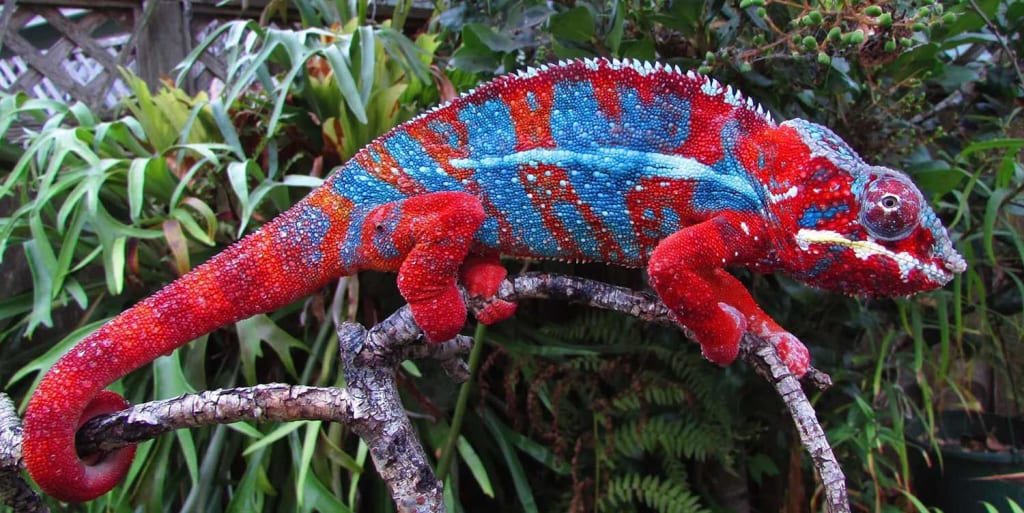What Does It Mean When a Panther Chameleon Turns Red?
The significance behind the color change of a panther chameleon.

Panther chameleons (Furcifer pardalis) are mesmerizing creatures known for their ability to change colors. These stunning reptiles showcase an astonishing array of hues, patterns, and shades. While their color-changing abilities primarily serve as a means of communication, defense, and thermoregulation, there is one color change that captures the attention of chameleon enthusiasts and researchers alike—the vibrant red display.
In this article, we will explore the fascinating world of panther chameleons and delve into the significance behind their stunning red coloration. By understanding the underlying factors that trigger this remarkable transformation, we can gain insights into the chameleon's behavior, health, and environmental adaptation.
Panther Chameleon Basics
Before delving into the enigma of red coloration in panther chameleons, it is essential to establish a foundational understanding of these reptiles. Panther chameleons are native to the tropical rainforests of Madagascar and are renowned for their unique physical characteristics and extraordinary color-changing abilities.
Panther chameleons exhibit sexual dimorphism, with males being larger and more vibrantly colored than females. They possess a prehensile tail, independently moving eyes, a long tongue used to catch prey, and specialized feet for climbing. The chameleons' most distinctive feature is their ability to change colors rapidly, aided by specialized cells called chromatophores.
The Mechanism of Color Change
To comprehend why a panther chameleon turns red, we must first understand the process of color change. Panther chameleons possess three layers of specialized cells in their skin: the iridophores, xanthophores, and erythrophores. These cells contain pigments that reflect or absorb light, resulting in various color combinations.
The color change occurs due to the chameleon's ability to manipulate these pigment cells. Hormonal signals and external factors like temperature, light, and emotional state influence the contraction or expansion of these cells, causing the reflection and absorption of light at different wavelengths. This intricate process enables the chameleon to adapt to its environment, regulate body temperature, and communicate with conspecifics.
The Significance of Red Coloration
While panther chameleons are renowned for their ability to exhibit a broad spectrum of colors, the vivid red display holds particular significance. Here are some of the key reasons a panther chameleon might turn red:
Mating and Territory:
In the animal kingdom, vibrant colors often play a crucial role in attracting potential mates and defending territories. Male panther chameleons frequently exhibit intense red coloration during courtship displays to attract females. The bright red acts as a visual signal of their fitness and dominance, demonstrating their genetic quality to potential mates.
Aggression and Threat Display:
Red coloration in panther chameleons can also serve as a warning signal to rivals or predators. When threatened or engaged in territorial disputes, males may turn red to assert dominance and intimidate rivals. The bold red color acts as a visual deterrent, discouraging potential challengers.
Stress and Health Indicators:
In some cases, a panther chameleon turning red may indicate stress or poor health. Stressors such as inappropriate environmental conditions, handling, or illness can trigger a stress response in chameleons, resulting in a red or darkened coloration. It is crucial to monitor other behavioral and physical signs to identify and address potential health issues promptly.
Temperature Regulation:
Chameleons are ectothermic creatures, relying on external heat sources to regulate their body temperature. The ability to change color assists them in optimizing their heat absorption or dissipation. When a panther chameleon turns red, it could indicate an attempt to absorb solar radiation to warm its body or, conversely, to reflect excess heat to cool down.
Suggested Read: Discover What You Really Need to Know to Raise a Happy, Healthy Pet Chameleon! And Avoid The No.1 Cause Of Death of Chameleons in Captivity... Here's Your Chance to Find Out.
Conclusion
The mesmerizing color-changing abilities of panther chameleons have captivated researchers and enthusiasts for years. While their ability to turn red serves various purposes, including attracting mates, asserting dominance, displaying aggression, and regulating body temperature, it is essential to interpret this color change within the broader context of the chameleon's behavior, health, and environment.
Observing a panther chameleon turning red should prompt chameleon keepers to assess their pet's well-being, evaluate the environmental conditions, and ensure a balanced and appropriate diet. Stress, illness, or inadequate husbandry practices may lead to unwanted color changes, warranting immediate attention.
By deepening our understanding of the mechanisms and significance of color change in panther chameleons, we can cultivate a greater appreciation for these remarkable creatures and provide them with optimal care. Let us embrace the fascinating world of the panther chameleon, where color tells a story, and every shade reflects nature's wisdom.
Disclosure
“We are a participant in the Clickbank Affiliate Program, an affiliate advertising program designed to provide a means for us to earn fees by linking to Clickbank.com and affiliated sites at no extra cost to you.”
About the Creator
Chameleon Care Secrets
Chameleon Care Secrets reveals the hidden knowledge behind successfully caring for chameleons. Discover expert tips, husbandry secrets, and essential techniques to ensure your chameleons thrive in their habitats.






Comments
There are no comments for this story
Be the first to respond and start the conversation.